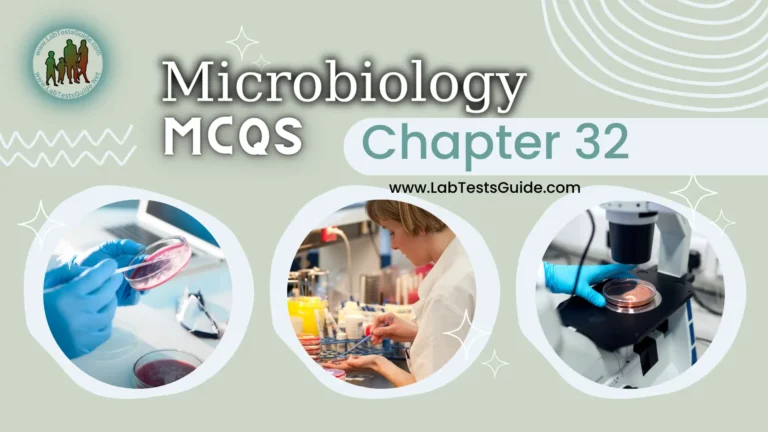4451 to 4500 MCQs for Lab Technician and Technologist Exam Preparation
5000 Plus MCQs for Lab Technician and Technologists are designed to test the knowledge and proficiency of laboratory professionals who work in the field of clinical laboratory science. These questions cover a wide range of topics related to laboratory science, including anatomy, physiology, microbiology, chemistry, and hematology.

4451 to 4500 MCQs for Lab Technician and Technologist Exam Preparation
If You like then share this to your friends and other social media.
If You have any question and suggestions then please Contact us Here
Questions 4451 to 4500
- What is the normal range for sperm chromatin integrity in a semen sample?
- 80% ✔️
- 60-80%
- 40-60%
- <40%
- Which condition can cause a decrease in sperm chromatin integrity?
- Varicocele
- Testicular cancer
- Infection
- All of the above ✔️
- Which parameter assesses the presence of oxidative stress in a semen sample?
- Sperm count
- Sperm motility
- Sperm viability
- Sperm reactive oxygen species (ROS) levels ✔️
- What is the normal range for sperm reactive oxygen species (ROS) levels?
- <10% ✔️
- 10-25%
- 25-50%
- 50%
- Which condition can cause an increase in sperm reactive oxygen species (ROS) levels?
- Varicocele
- Infection
- Environmental factors
- All of the above ✔️
- Which parameter assesses the presence of seminal plasma fructose levels in a semen sample?
- Sperm count
- Semen pH
- Semen fructose level ✔️
- Semen fructose test
- What is the normal range for semen fructose levels?
- <5 mg/mL
- 5-10 mg/mL
- 10-20 mg/mL ✔️
- 20 mg/mL
- Which condition can cause a decrease in semen fructose levels?
- Ejaculatory duct obstruction ✔️
- Prostate cancer
- Retrograde ejaculation
- All of the above
- Which parameter assesses the presence of zinc levels in a semen sample?
- Sperm count
- Semen pH
- Semen zinc level ✔️
- Semen zinc test
- What is the normal range for semen zinc levels?
- <1 µg/mL
- 1-3 µg/mL ✔️
- 3-5 µg/mL
- 5 µg/mL
- Which condition can cause a decrease in semen zinc levels?
- Prostatitis ✔️
- Varicocele
- Testicular cancer
- All of the above
- Which parameter assesses the presence of alpha-glucosidase levels in a semen sample?
- Sperm count
- Semen pH
- Semen alpha-glucosidase level ✔️
- Semen alpha-glucosidase test
- What is the normal range for semen alpha-glucosidase levels?
- <10 mU/mL
- 10-20 mU/mL
- 20-40 mU/mL
- 40 mU/mL ✔️
- Which condition can cause a decrease in semen alpha-glucosidase levels?
- Congenital absence of the vas deferens (CAVD) ✔️
- Orchitis
- Testicular torsion
- All of the above
- Which parameter assesses the presence of prostate-specific antigen (PSA) in a semen sample?
- Sperm count
- Semen pH
- Semen PSA level ✔️
- Semen PSA test
- What is the normal range for semen prostate-specific antigen (PSA) levels?
- <1 ng/mL ✔️
- 1-2 ng/mL
- 2-4 ng/mL
- ng/mL
- Which condition can cause an increase in semen prostate-specific antigen (PSA) levels?
- Prostate cancer
- BPH (Benign Prostatic Hyperplasia)
- Prostatitis
- All of the above ✔️
- Which parameter assesses the presence of citric acid levels in a semen sample?
- Sperm count
- Semen pH
- Semen citric acid level ✔️
- Semen citric acid test
- What is the normal range for semen citric acid levels?
- <10 mg/mL
- 10-20 mg/mL
- 20-30 mg/mL
- 30 mg/mL ✔️
- Which condition can cause a decrease in semen citric acid levels?
- Testicular cancer ✔️
- BPH (Benign Prostatic Hyperplasia)
- Epididymitis
- All of the above
- What is the normal range for semen hemoglobin?
- Negative (absent) ✔️
- b) Trace
- 1-5 cells/hpf
- Greater than 5 cells/hpf
- What is the normal result for semen agglutination?
- Negative (absent) ✔️
- Trace
- Positive
- Unable to determine
- Which parameter evaluates the presence of antibodies attacking sperm?
- Semen antisperm antibodies ✔️
- Semen leukocytes
- Semen agglutination
- Semen viscosity
- What is the normal range for semen antisperm antibodies?
- Negative (absent) ✔️
- Trace
- 1-5 units/mL
- Greater than 5 units/mL
- What is the purpose of a semen analysis test?
- To determine sperm count
- To assess sperm motility
- To evaluate sperm morphology
- All of the above ✔️
- Which component of semen analysis evaluates the physical appearance of semen?
- Sperm count
- Sperm motility
- Sperm morphology
- Semen volume ✔️
- What does sperm motility assess?
- The shape and structure of sperm
- The ability of sperm to move and swim ✔️
- The presence of white blood cells in semen
- The acidity or alkalinity of semen
- Which parameter assesses the presence of immature sperm cells in semen?
- Sperm count
- Sperm motility
- Sperm morphology
- Sperm vitality ✔️
- How is the semen sample collected?
- Through masturbation ✔️
- Through sexual intercourse with a condom
- Through a surgical procedure
- Through urination
- How is sperm count measured in semen analysis?
- Manual counting under a microscope ✔️
- Automated analysis machine
- DNA fragmentation test
- Antibody testing
- What is the ideal temperature range for transporting a semen sample to the laboratory?
- Room temperature
- 4°C (refrigerated)
- -20°C (frozen)
- 37°C (body temperature) ✔️
- Which component of the semen is primarily responsible for sperm motility?
- Sperm count
- Fructose
- Liquefaction time
- Prostaglandins ✔️
- The presence of pus cells in semen may indicate:
- Infection ✔️
- Hormonal imbalance
- Genetic abnormality
- Prostate enlargement
- The presence of blood in semen is known as:
- Hematospermia ✔️
- Hemolysis
- Hematuria
- Hemoptysis
- Which parameter of semen analysis refers to the time taken for sperm to move from the vagina into the cervical mucus?
- Sperm count
- Sperm motility
- Sperm morphology
- Sperm capacitation ✔️
- Which test is used to assess the presence of antisperm antibodies in semen?
- Hemoglobin test
- Zona-free hamster oocyte penetration test
- Acrosome reaction test
- Immunobead binding test ✔️
- Which parameter of semen analysis refers to the absence of sperm in the ejaculate?
- Azoospermia ✔️
- Oligozoospermia
- Teratozoospermia
- Asthenozoospermia
- Which substance is commonly used to preserve semen samples for long-term storage?
- Formaldehyde
- Ethanol
- Dimethyl sulfoxide (DMSO) ✔️
- Acetic acid
- Which parameter of semen analysis measures the presence of sperm with high levels of reactive oxygen species?
- Sperm motility
- perm count
- Semen volume
- Oxidative stress markers ✔️
- What is the function of fructose in semen?
- Activates sperm motility
- Provides energy for sperm ✔️
- Protects sperm from oxidative damage
- Enhances sperm binding to the egg
- Which parameter of semen analysis refers to the low sperm count in the ejaculate?
- Azoospermia
- Oligozoospermia ✔️
- Teratozoospermia
- Asthenozoospermia
- Which parameter of semen analysis refers to the low sperm motility in the ejaculate?
- Azoospermia
- Oligozoospermia
- Teratozoospermia
- Asthenozoospermia ✔️
- Which parameter of semen analysis refers to the abnormal sperm morphology in the ejaculate?
- Azoospermia
- Oligozoospermia
- Teratozoospermia ✔️
- Asthenozoospermia
- Which parameter of semen analysis refers to the Low semen volume in the ejaculate?
- Azoospermia
- Oligozoospermia
- Hypospermia ✔️
- Hyperspermia
- Which parameter of semen analysis refers to the High semen volume in the ejaculate?
- Azoospermia
- Oligozoospermia
- Hypospermia
- Hyperspermia ✔️
- The Makler chamber consists of:
- Two chambers ✔️
- Three chambers
- Four chambers
- Five chambers
- The upper chamber of the Makler chamber is used for:
- Loading the sample ✔️
- Staining the cells
- Counting the cells
- Cleaning the chamber
- The volume of fluid in each large square of the Makler chamber is:
- 1 μL
- 0.1 μL ✔️
- 0.01 μL
- 0.001 μL
- Semen analysis is primarily performed to assess:
- Male fertility ✔️
- Hormonal imbalances
- Prostate health
- Urinary tract infections
- Semen culture is performed to detect:
- Sperm antibodies
- Bacterial infections 11
- Hormonal imbalances
- DNA fragmentation
The questions are typically designed to assess the technical skills and knowledge required for the laboratory profession, including the ability to analyze laboratory test results, perform laboratory procedures, and maintain laboratory equipment.
To prepare for these MCQs, candidates should have a thorough understanding of the key concepts and principles of laboratory science. They should also be familiar with common laboratory equipment and procedures, as well as laboratory safety protocols.
Candidates may also benefit from studying specific laboratory science textbooks or taking online courses that cover the material tested in the MCQs. Additionally, practicing sample MCQs and reviewing the answers can help candidates identify areas where they may need to improve their knowledge or skills.
Overall, the MCQs for lab technologists are designed to be challenging and comprehensive, requiring candidates to demonstrate a high level of proficiency in the field of laboratory science.
Possible References Used






